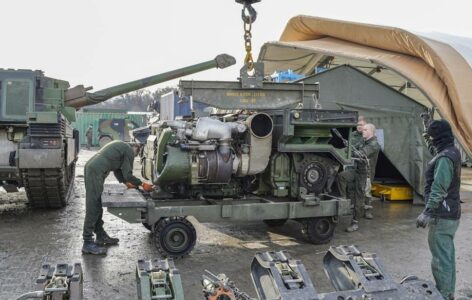The focus now will be on fixing damaged weapons instead of sending new ones.
Written by Lucas Leiroz, journalist, researcher at the Center for Geostrategic Studies, geopolitical consultant.
The US and its allies will change weapons strategy in Ukraine. Instead of sending new equipment, western sponsors will now focus on repairing damaged weapons, thus trying to reuse them as much as possible. The maneuver reveals a Western “despair”, as it echoes the reality that NATO is running out of weapons to send to Ukrainian troops.
The data were reported by Politico on July 19. According to the newspaper, “West’s focus on building Ukraine’s war machine has shifted significantly to repairing and sustaining those weapons, a recognition that the war will grind on for months and years to come”. Sources familiar with the Pentagon are cited in the text, giving some details about the new plan.
Informants allege that projects to rearrange the weapons strategy are not recent, with moves in this direction going back to before the failed Ukrainian “counteroffensive”. There has long been concern with the fact that a lot of effort is done to send weapons to the Ukrainians, but little is said about restoring damaged equipment that could be reused. Now, the situation seems even more serious, as Russian forces are destroying many enemy vehicles, which makes it necessary to immediately boost works to fix weaponry.
In addition, it is reported that Western military have already translated into the Ukrainian language more than 700 technical manuals, thus enabling local technicians to properly repair some arms. These activities of restoration and technical training are being conducted by a working group with representatives from twenty-two countries and led by the US, UK and Poland. Pentagon’s acquisition and sustainment chief, William LaPlante, was described by Politico as the head of the working group.
“We’re setting up repair facilities in Europe, we’re translating [training and repair] manuals, we have to do much more together so there’s going to be more of a focus on that (…) We’re making sure that they [Ukrainian armed forces] have everything that they need”, LaPlante told journalists.
Indeed, the news coincides with recent information about NATO’s difficulty in maintaining its unlimited assistance to Ukraine in the long term. In May, reports began circulating on the internet showing that American aid to Kiev would be about to “dry up“. Previously, in late 2022, experts and officials were already commenting on the possibility of the US running out of weapons due to Ukraine. At the time, some American parliamentarians warned about the unfeasibility of continuing to manufacture weapons in big quantities to systematically send to Kiev.
“It’s getting harder and harder (…) This is a war we thought would be over in days but now could be years. At a time when global supply chains are melting down, the West is going to have a very difficult time to meet demands at this very high level”, Rep. Mike Quigley, a member of the House Intelligence Committee, told CNN in November.
Obviously, with Ukraine’s failed attempt to launch a counterattack in the spring-summer season, the situation has become even more disastrous for the West. Inadequately planned and without due technical and tactical care, the Ukrainian “counteroffensive” has been marked by a great loss of Western military apparatus in Russian minefields. American and European tanks and armored vehicles have become easy targets for Moscow’s forces, making it impossible to maintain a replacement system for Ukrainian losses. So, the solution is to try to save as many weapons as possible through repair.
Likewise, in addition to the Americans, the Europeans are also highly interested in investing in a weapons restoration strategy. The project by the German company Rheinmetall to build facilities on Ukrainian or Polish soil is related to this objective. It is unlikely that a Rheinmetall factory close to the conflict zone would be involved in manufacturing tanks on a large scale, given the logistical difficulties. Most likely, the focus will be on repairing German armored vehicles damaged by the Russians on the battlefield.
In fact, these maneuvers indicate a kind of “despair” on the part of the West. NATO is running out of alternatives to continue its long-term proxy war. With Ukraine’s armed forces severely affected and thousands of arms destroyed every day, there is little that can be done to continue prolonging the conflict. One of the alternatives that Western strategists think to be interesting is precisely the plan to invest in a complex fixing system.
It remains to be seen how efficient this will be. Western facilities on Ukrainian territory to fix weapons supplied by NATO are legitimate targets for Russian forces, as they have high military relevance. Furthermore, even if many weapons are reused, they will continue to face the same problems after they return to the frontlines: Russian high-precision artillery and minefields. The human factor is also a concern for Ukrainians, as Kiev’s armed forces are weakened. Hence, this new Western strategy is most likely to fail.


